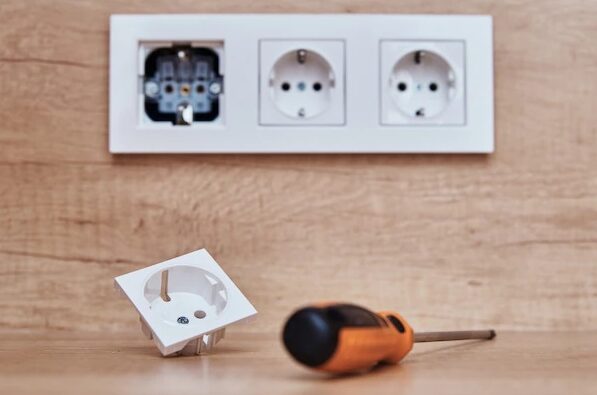Yes, it should be in an AFCI. As of the 2014 NEC, all 15A and 20A 120V kitchen outlets (not just receptacles, but lights and fixtures as well) must be AFCI protected.
Some range hoods need a separate circuit, but it depends on the model. If you read the instructions for the hood, you can probably connect it to the lighting circuit.
In most cases, an electric range needs its own 240/250-volt, 50-amp circuit. To power the range, you will need to run 6/3 NM cable or #6 THHN cable in one conductor. If it’s a gas stove, on the other hand, the controls and vent hood will only need a 120/125-volt outlet.
Even if you won’t be using the electric range circuit right now, it’s a good idea to install it during a major remodel. In the future, you may want to trade in an electric stove, and if you ever sell your house, having this circuit will be a huge plus. Don’t forget that an electric stove needs to be pushed against the wall, so put the outlet in the right place.
50-amp circuits are typical for ranges, but some units may need circuits up to 60-amps. Smaller units may only need 40-amp or even 30-amp circuits. But most new homes are built with 50-amp range circuits because this is enough power for the vast majority of domestic kitchen ranges.
In most kitchens with a separate cooktop and wall oven, the National Electrical Code says that both can be powered by the same circuit as long as the total electrical load does not exceed the safe limit of the circuit. But usually, two, thirty, or forty amp circuits are run from the main panel to feed each one separately.

Does the range hood need GFCI?
Even if the outlet is behind the stove, it should have GFCI protection if it’s within 6 feet of the sink. The same with small appliances, range hood, microwave, dishwasher, garbage disposal, refrigerator, and other kitchen circuits.
Range hoods do not have to be on a separate circuit. They can be hardwired or plugged into the outlet of a lighting circuit. Although it is technically possible to connect it to a normal kitchen socket, it is not a good idea due to restrictions.
The hardwired range hood does not have to be connected to a GFCI. If it happens every time you turn on the blower motor, it’s a common nuisance trip. Also, there may be INTENTIONAL ground faults there to destroy the home RFI.
If it only happens sometimes when the motor is running, I’d be concerned that the windings or a path around the brushes would break or become clogged with something conductive, causing an actual failure.
NEC Dedicated Circuit Requirements
The National Electrical Code (NEC) says kitchen counter outlets must be on at least two separate 20-amp, 120-volt circuits that are no more than 4 feet apart.
The National Electrical Code says that any appliance or device that is considered “critical” must have its dedicated circuit. This is to ensure that another appliance or device does not trip the breaker and turn off the critical accessory. Some of these major appliances are furnaces, water heaters, sump pumps, and even refrigerators. If you don’t know one of these switches has tripped, you could end up with a flooded basement, a freezing house, no hot water, or a fridge full of spoiled food.
Different models use different amounts of wattage, so for some of the items on the list, a dedicated circuit may not be necessary. It depends on how often and how long you use it. Talk to an electrician about what you need from your circuits, and always err on the side of safety.
Conclusion
Changing the kitchen is a difficult job. Many things need to be carefully thought through. Not only do you have to choose cabinets, countertops, sinks, lights, and appliances, but you also have to think about how to wire the kitchen for electricity.
Since electrical codes often change, you should be sure to follow the rules in your area. Since there are many appliances in the kitchen, the National Electrical Code says there must be more than one circuit. In a modern kitchen, you need seven or eight circuits, but in a bedroom, one general-purpose lighting circuit is enough.
